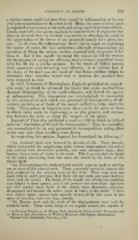Page 725 - My FlipBook
P. 725
ETIOLOGY OF CARIES. 735
a similar course, could not have been caused by inflammation or by any-
vital process pertaining to the tooth itself. Hence the cause of decay must
be regarded as extraneous to the teeth and acting upon them from without.
Harris, especially, has given emphasis to another form of argument that
deserves mention from its intrinsic importance in educating the mind to
the appreciation of the fitness of any proposed remedy for a given dis-
ease. At the time the inflammatory theory was in vogue as explaining
the nature of caries, the best authorities, although recommending the
operation of filling the carious cavities, expected only temporary relief
from it. But it was rapidly becoming the custom to All the cavities
for the purpose of curing the affection, also to remove superficial decay
with the file for a similar purpose. In the hands of skilled persons
these operations were becoming very effective. It is evident that if
the decay of the tooth was the result of vital forces resident within its
substance, these remedies would tend to increase the mischief they
were designed to cure.
In 1835, Robertson of Birmingham, England, published his remark-
able work,^ in which he advanced the theory that caries resulted from
chemical disintegration of the tooth-substance, and denied the agency
of inflammation. This destruction was accomplished, he contended,
by the action of an acid which was generated by decomposition of ali-
mentary particles or of fluids of the mouth suffered to lodge about the
teeth. These points of lodgment were shown to be the same as those
in which caries made its beginnings, as in pits, grooves, and crevices,
also between the teeth or about the margins of the gums.
Regnard of Paris also published a work in 1838 in which he defined
caries as ^'destruction of the teeth by decomposition.''' This, he contended,
was accomplished by an acid generated by decompositions taking place
in the very spot where its effects were shown.
As supporting this opinion, Regnard has formulated the following :^
" 1st. Artificial teeth were fastened by threads of silk. These threads,
which surrounded the neighboring teeth, became impregnated with saliva
and covered with alimentary particles, and soon corrupted them ; they
became then a cause of caries to the teeth. This is so true that the limits
of the caries j^roceeding from this cause are traced by the limits of the
thread itself.
" 2d. For sustaining the artificial teeth metallic caps are made to envelop
one or more of the natural teeth. These constantly served to remove the
pain produced by the wearing away of the teeth. These caps were not
made with so much precision that there did not exist any space between
them (and the teeth). The fluids of the mouth, the alimentary particles,
soon lodged in these spaces ; and if the persons who wore these caps were
not very careful, these fluids of the mouth, these alimentary particles,
decomposed and became the active cause of caries to the teeth. I have
seen molars whose crowns were entirely destroyed by this cause in the
space of six, five, and even four, months.
" 3d. Human teeth and the teeth of the hippopotamus were used for
artificial teeth. These teeth, being of an organic nature, are capable of
^ A Practical Treatise on the Human Teeth, f^hnwivc/ the Cans^es of thnr Defitrnclion and
the Meana of their Preservation, by William Robertson, Old Square, Birmingham.
'Quoted from Desirabode, Part 1st, p. 169.


